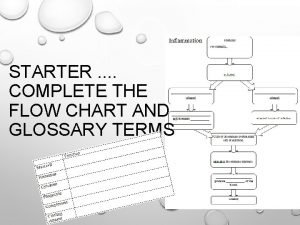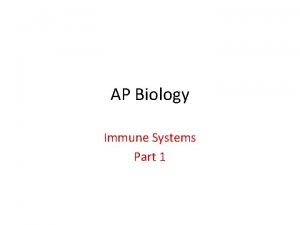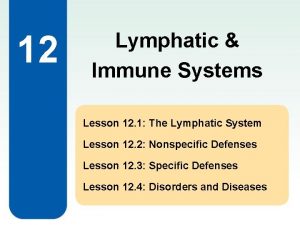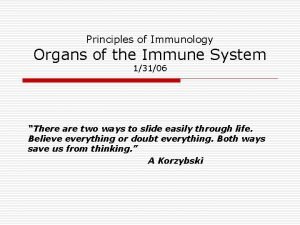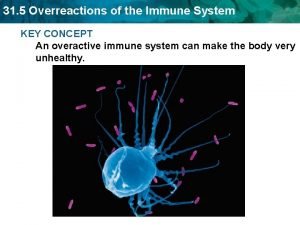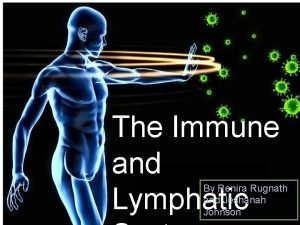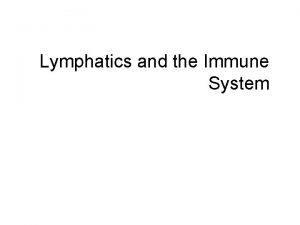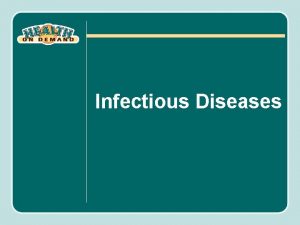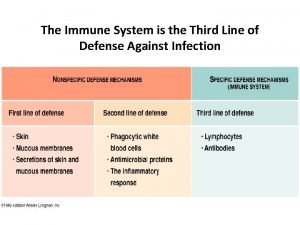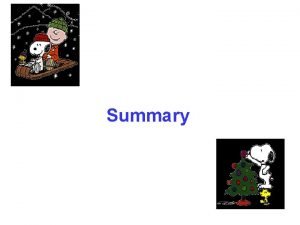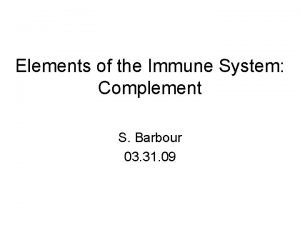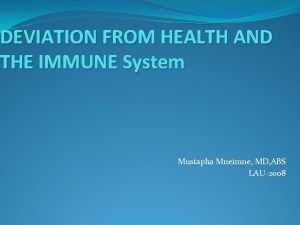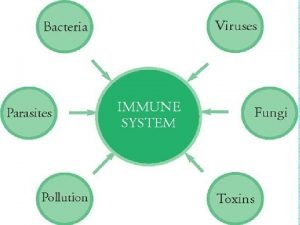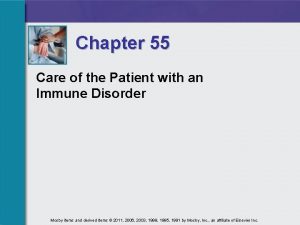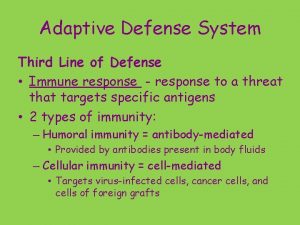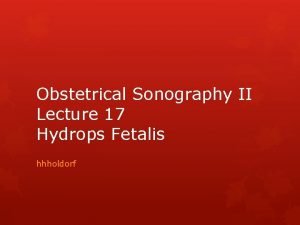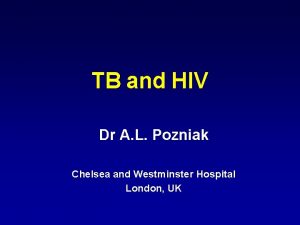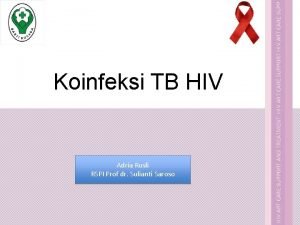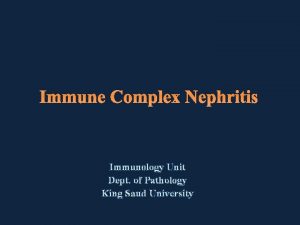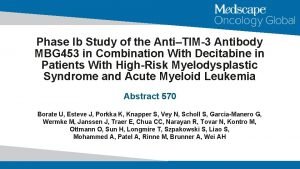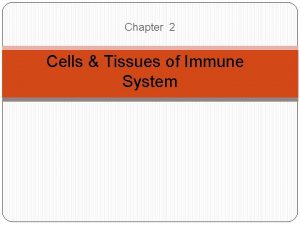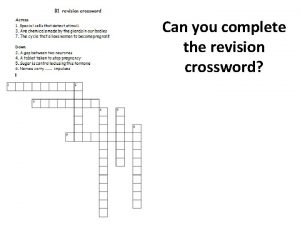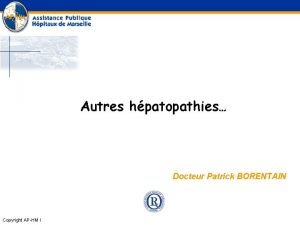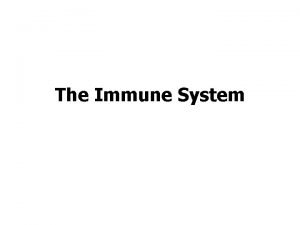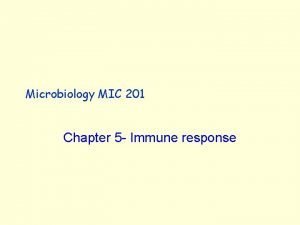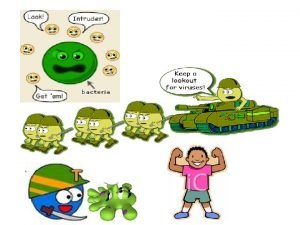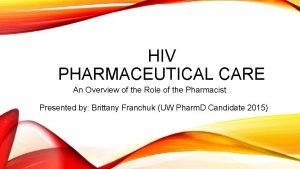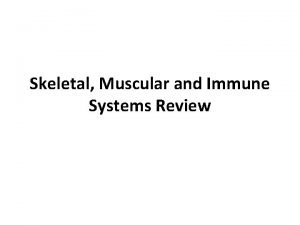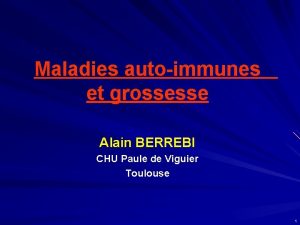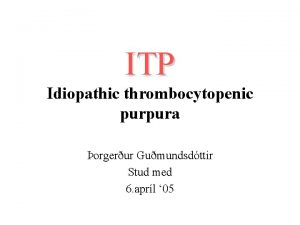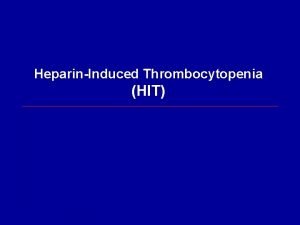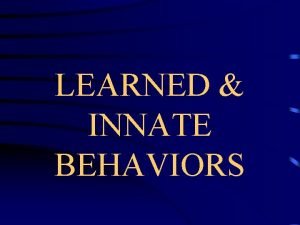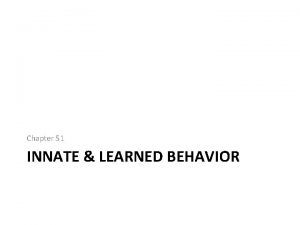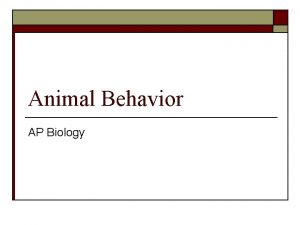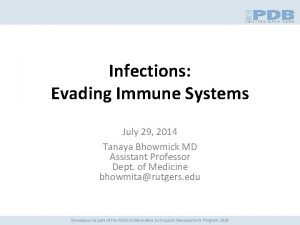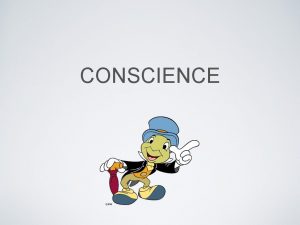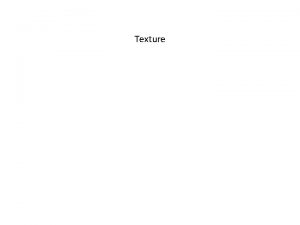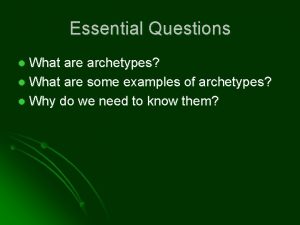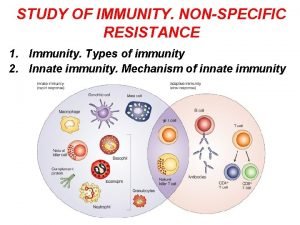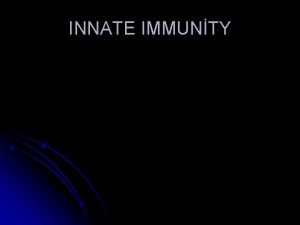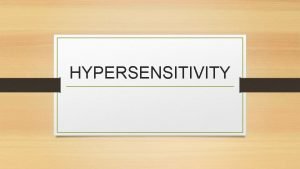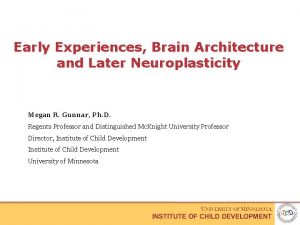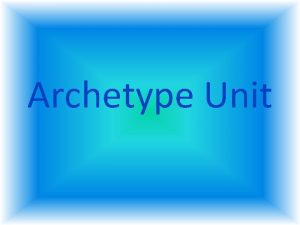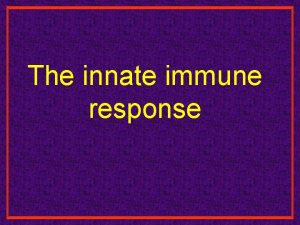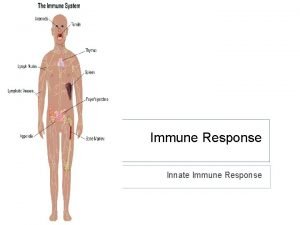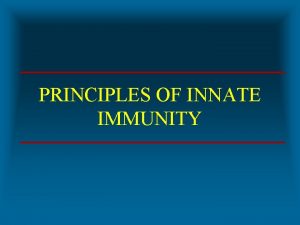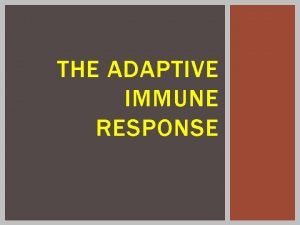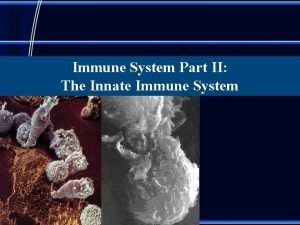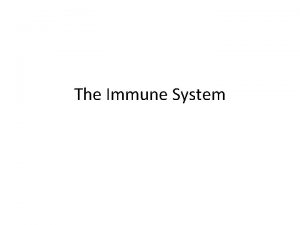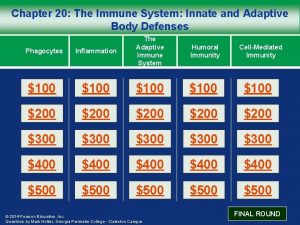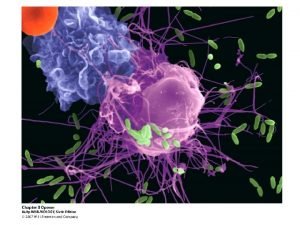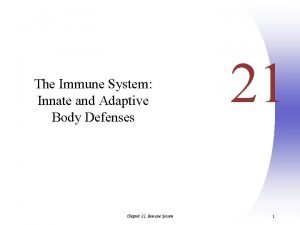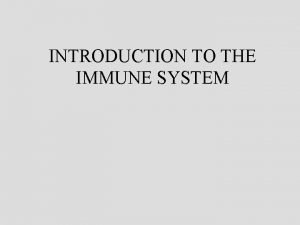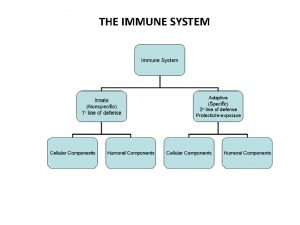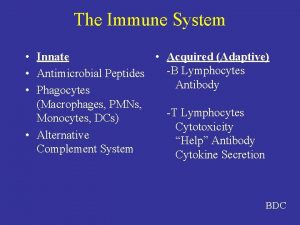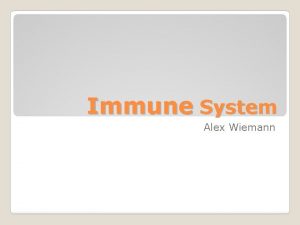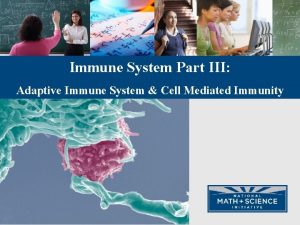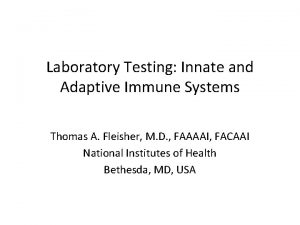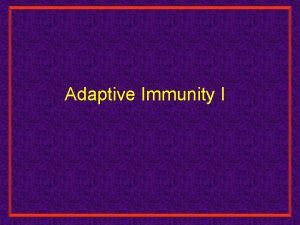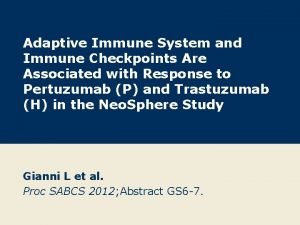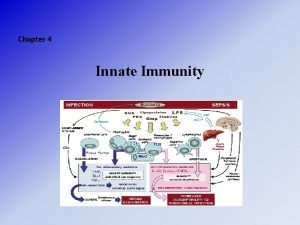Chapter 21 16 The Immune System Innate Adaptive






















































































- Slides: 86

Chapter 21 16 The Immune System: Innate & Adaptive Body Defenses

Immunity • Resistance to disease • Immune system has two intrinsic systems –Innate (nonspecific) defense system –Adaptive (specific) defense system

Immunity 1. Innate defense system has two lines of defense –First line of defense is external body membranes (skin and mucosae) –Second line of defense is antimicrobial proteins, phagocytes, and other cells • Inhibit spread of invaders • Inflammation is its most important mechanism

Immunity 1. Adaptive defense system –Third line of defense attacks particular foreign substances • Takes longer to react than the innate system • Innate and adaptive defenses are deeply intertwined

Surface barriers • Skin • Mucous membranes Innate defenses Internal defenses • Phagocytes • NK cells • Inflammation • Antimicrobial proteins • Fever Humoral immunity • B cells Adaptive defenses Cellular immunity • T cells Figure 21. 1

Innate Defenses • Surface barriers –Skin, mucous membranes, and their secretions • Physical barrier to most microorganisms • Keratin is resistant to weak acids and bases, bacterial enzymes, and toxins –Mucosae provide similar mechanical barriers

Surface Barriers • Protective chemicals inhibit or destroy microorganisms –Skin acidity –Lipids in sebum and dermcidin in sweat –HCl and protein-digesting enzymes of stomach mucosae –Lysozyme of saliva and lacrimal fluid –Mucus with defensins

Surface Barriers • Respiratory system modifications –Mucus-coated hairs in the nose –Cilia of upper respiratory tract sweep dust- and bacteria-laden mucus from lower respiratory passages

Internal Defenses: Cells and Chemicals • Necessary if microorganisms invade deeper tissues –Phagocytes –Natural killer (NK) cells –Inflammatory response (macrophages, mast cells, WBCs, and inflammatory chemicals) –Antimicrobial proteins (interferons and complement proteins) –Fever

Phagocytes: Macrophages • Macrophages develop from monocytes to become the chief phagocytic cells • Free macrophages wander through tissue spaces –E. g. , alveolar macrophages • Fixed macrophages are permanent residents of some organs –E. g. , Kupffer cells (liver) and microglia (brain)

Phagocytes: Neutrophils • Neutrophils –Become phagocytic on encountering infectious material in tissues

Mechanism of Phagocytosis Step 1: Adherence of phagocyte to pathogen –Facilitated by opsonization—coating of pathogen by complement proteins or antibodies

Innate defenses Internal defenses (a) A macrophage (purple) uses its cytoplasmic extensions to pull spherical bacteria (green) toward it. Scanning electron micrograph (1750 x). Figure 21. 2 a

1 Phagocyte adheres to pathogens or debris. Lysosome Phagosome (phagocytic vesicle) Acid hydrolase enzymes (b) Events of phagocytosis. 2 Phagocyte forms pseudopods that eventually engulf the particles forming a phagosome. 3 Lysosome fuses with the phagocytic vesicle, forming a phagolysosome. 4 Lysosomal enzymes digest the particles, leaving a residual body. 5 Exocytosis of the vesicle removes indigestible and residual material. Figure 21. 2 b

Opsonization The coating of foreign cells with “sticky” particles. l. These particles can be antibodies or complement proteins. l. Opsonized bodies are easier to phagocytize, and/or trigger phagocytosis. l

Mechanism of Phagocytosis • Destruction of pathogens –Acidification and digestion by lysosomal enzymes –Respiratory burst • Release of cell-killing free radicals • Activation of additional enzymes –Oxidizing chemicals (e. g. H 2 O 2) –Defensins (in neutrophils)

Natural Killer (NK) Cells • Large granular lymphocytes • Target cells that lack “self” cell-surface receptors • Induce apoptosis in cancer cells and virusinfected cells • Secrete potent chemicals that enhance the inflammatory response

Inflammatory Response • Triggered whenever body tissues are injured or infected • Prevents the spread of damaging agents • Disposes of cell debris and pathogens • Sets the stage for repair

Inflammatory Response • Cardinal signs of acute inflammation: 1. Redness 2. Heat 3. Swelling 4. Pain (And sometimes 5. Impairment of function)

Inflammatory Response • Macrophages and epithelial cells of boundary tissues bear Toll-like receptors (TLRs) • TLRs recognize specific classes of infecting microbes • Activated TLRs trigger the release of cytokines that promote inflammation

Inflammatory Response • Inflammatory mediators –Histamine (from mast cells) –Blood proteins –Kinins, prostaglandins (PGs), leukotrienes, and complement • Released by injured tissue, phagocytes, lymphocytes, basophils, and mast cells

Vasodilation and Increased Vascular Permeability • Inflammatory chemicals cause –Dilation of arterioles –Increased permeability of local capillaries and edema (leakage of exudate) • Exudate contains proteins, clotting factors, and antibodies

Inflammatory Response: Edema • Functions of the surge of exudate –Moves foreign material into lymphatic vessels –Delivers clotting proteins to form a scaffold for repair and to isolate the area

Innate defenses Internal defenses Tissue injury Release of chemical mediators (histamine, complement, kinins, prostaglandins, etc. ) Release of leukocytosisinducing factor Leukocytosis (increased numbers of white blood cells in bloodstream) Initial stimulus Vasodilation of arterioles Increased capillary permeability Attract neutrophils, monocytes, and lymphocytes to area (chemotaxis) Local hyperemia (increased blood flow to area) Capillaries leak fluid (exudate formation) Leukocytes migrate to injured area Margination (leukocytes cling to capillary walls) Physiological response Signs of inflammation Leaked protein-rich fluid in tissue spaces Result Heat Redness Locally increased temperature increases metabolic rate of cells Pain Swelling Possible temporary limitation of joint movement Leaked clotting proteins form interstitial clots that wall off area to prevent injury to surrounding tissue Temporary fibrin patch forms scaffolding for repair Diapedesis (leukocytes pass through capillary walls) Phagocytosis of pathogens and dead tissue cells (by neutrophils, short-term; by macrophages, long-term) Pus may form Area cleared of debris Healing Figure 21. 3

Phagocyte Mobilization • Neutrophils, then phagocytes flood to inflamed sites

Phagocyte Mobilization • Steps for phagocyte mobilization 1. Leukocytosis: release of neutrophils from bone marrow in response to leukocytosis-inducing factors from injured cells 2. Margination: neutrophils cling to the walls of capillaries in the inflamed area 3. Diapedesis of neutrophils 4. Chemotaxis: inflammatory chemicals (chemotactic agents) promote positive chemotaxis of neutrophils

Innate defenses Internal defenses Inflammatory chemicals diffusing from the inflamed site act as chemotactic agents. Leukocytosis. Neutrophils enter blood from bone marrow. 1 Margination. Neutrophils cling to capillary wall. 2 Chemotaxis. Neutrophils follow chemical trail. Capillary wall Basement membrane Endothelium 4 Diapedesis. Neutrophils flatten and squeeze out of capillaries. 3 Figure 21. 4

Antimicrobial Proteins • Interferons (IFNs) and complement proteins –Attack microorganisms directly –Hinder microorganisms’ ability to reproduce

Interferons • Viral-infected cells are activated to secrete Interferons (IFNs) • IFNs enter neighboring cells • Neighboring cells produce antiviral proteins that block viral reproduction • Produced by a variety of WBCs

Innate defenses Virus Viral nucleic acid 1 Virus Internal defenses New viruses enters cell. 5 Antiviral proteins block viral reproduction. 2 Interferon genes switch on. DNA Nucleus m. RNA 4 Interferon 3 Cell produces interferon molecules. Host cell 1 Infected by virus; makes interferon; is killed by virus Interferon Host cell 2 Binds interferon from cell 1; interferon induces synthesis of protective proteins binding stimulates cell to turn on genes for antiviral proteins. Figure 21. 5

Interferons • Functions –Anti-viral –Reduce inflammation –Activate macrophages and mobilize NK cells • Genetically engineered IFNs for –Antiviral agents against hepatitis and genital warts virus –Multiple sclerosis treatment

Complement • ~20 blood proteins that circulate in an inactive form • Include C 1–C 9, factors B, D, and P, and regulatory proteins • Major mechanism for destroying foreign substances

Complement • Amplifies all aspects of the inflammatory response • Kills bacteria and certain other cell types by cell lysis • Enhances both nonspecific and specific defenses • Can be used to opsonize bacteria

Fever • Systemic response to invading microorganisms • Leukocytes and macrophages exposed to foreign substances secrete pyrogens • Pyrogens reset the body’s thermostat upward • High fevers are dangerous = heat denatures enzymes • Benefits of moderate fever –Causes the liver and spleen to sequester iron and zinc (needed by microorganisms) –Increases metabolic rate, which speeds up repair

Adaptive Defenses • The adaptive immune (specific defense) system –Protects against infectious agents and abnormal body cells –Amplifies the inflammatory response –Activates complement

Adaptive Defenses • Adaptive immune response –Is specific –Is systemic –Has memory • Two separate overlapping arms 1. Humoral (antibody-mediated) immunity 2. Cellular (cell-mediated) immunity

Antigens • Substances that can mobilize the adaptive defenses and provoke an immune response • Most are large, complex molecules not normally found in the body (nonself)

Antibody A Antigenbinding sites Antigenic determinants Antigen Antibody B Antibody C Figure 21. 7

Self-Antigens: MHC Proteins • Protein molecules (self-antigens) on the surface of cells • Antigenic to others in transfusions or grafts • Example: MHC proteins –Coded for by genes of the major histocompatibility complex (MHC) and are unique to an individual

MHC Proteins • Classes of MHC proteins –Class I MHC proteins, found on virtually all body cells –Class II MHC proteins, found on certain cells in the immune response • MHC proteins display peptides (usually self-antigens) • In infected cells, MHC proteins display fragments of foreign antigens, which help mobilize

Cells of the Adaptive Immune System • Two types of lymphocytes –B lymphocytes (B cells)—humoral immunity –T lymphocytes (T cells)—cell-mediated immunity • Antigen-presenting cells (APCs) –Any cell type that can present antigens to a Tlymphocyte –Do not respond to specific antigens –Play essential auxiliary roles in immunity

Lymphocytes • Originate in red bone marrow –B cells mature in the red bone marrow –T cells mature in the thymus

Lymphocytes • When mature, they have –Immunocompetence; they are able to recognize and bind to a specific antigen –Self-tolerance – unresponsive to self antigens • Naive (unexposed) B and T cells are exported to lymph nodes, spleen, and other lymphoid organs

Adaptive defenses Immature lymphocytes Red bone marrow: site of lymphocyte origin Humoral immunity Cellular immunity Primary lymphoid organs: site of development of immunocompetence as B or T cells Secondary lymphoid organs: site of antigen encounter, and activation to become effector and memory B or T cells Red bone marrow 1 Lymphocytes destined to become T cells migrate (in blood) to the thymus and develop immunocompetence there. B cells develop immunocompetence in red bone marrow. Thymus Bone marrow Lymph nodes, spleen, and other lymphoid tissues 2 Immunocompetent but still naive lymphocytes leave thymus and bone marrow. They “seed” the lymph nodes, spleen, and other lymphoid tissues where they encounter their antigen. 3 Antigen-activated immunocompetent lymphocytes (effector cells and memory cells) circulate continuously in the bloodstream and lymph and throughout the lymphoid organs of the body. Figure 21. 8

T Cells • T cells mature in the thymus under negative and positive selection pressures, in two sequential rounds. –Positive selection • Selects T cells capable of binding (at all) to self-MHC proteins (MHC restriction) –Negative selection • Prompts apoptosis of T cells that bind too tightly to selfantigens displayed by self-MHC • Ensures self-tolerance

Adaptive defenses Cellular immunity Positive selection: T cells must recognize self major histocompatibility proteins (self-MHC). Antigen. Developing presenting T cell thymic cell Failure to recognize self-MHC results in apoptosis (death by cell suicide). MHC Self-antigen T cell receptor Recognizing self-MHC results in MHC restriction—survivors are restricted to recognizing antigen on self-MHC. Survivors proceed to negative selection. Negative selection: T cells must not recognize self-antigens. Recognizing self-antigen results in apoptosis. This eliminates self-reactive T cells that could cause autoimmune diseases. Failure to recognize (bind tightly to) self-antigen results in survival and continued maturation. Figure 21. 9

B Cells • B cells mature in red bone marrow • Self-reactive B cells –Are eliminated by apoptosis (clonal deletion) or –Undergo receptor editing

Antigen Receptor Diversity • Lymphocytes make up to a billion different types of antigen receptors –Coded for by ~25, 000 genes –Gene segments are shuffled by somatic recombination • Genes determine which foreign substances the immune system will recognize and resist

Antigen-Presenting Cells (APCs) • Engulf antigens • Present fragments of antigens to be recognized by T cells • Major types –Dendritic cells in connective tissues and epidermis –Macrophages in connective tissues and lymphoid organs –B cells

Figure 21. 10

Macrophages and Dendritic Cells • Activated T cells release chemicals that –Prod macrophages to become insatiable phagocytes and to secrete bactericidal chemicals

Adaptive Immunity: Summary • Uses lymphocytes, APCs, and specific molecules to identify and destroy nonself substances • Depends upon the ability of its cells to –Recognize antigens by binding to them –Communicate with one another so that the whole system mounts a specific response

Humoral Immunity Response • Antigen challenge –First encounter between an antigen and a naive immunocompetent lymphocyte –Usually occurs in the spleen or a lymph node • If the lymphocyte is a B cell –The antigen provokes a humoral immune response –Antibodies are produced

Clonal Selection 1. B cell is activated when antigens bind to its surface receptors and cross-link them 2. Receptor-mediated endocytosis of cross-linked antigen-receptor complexes occurs 3. Stimulated B cell grows to form a clone of identical cells bearing the same antigen-specific receptors 4. (T cells are usually required to help B cells achieve full activation)

Fate of the Clones • Most clone cells become plasma cells –secrete specific antibodies at the rate of 2000 molecules per second for four to five days

Fate of the Clones • Secreted antibodies –Circulate in blood or lymph –Bind to free antigens –Mark the antigens for destruction

Fate of the Clones • Clone cells that do not become plasma cells become memory cells –Provide immunological memory –Mount an immediate response to future exposures of the same antigen

Adaptive defenses Humoral immunity Primary response (initial encounter with antigen) Activated B cells Plasma cells (effector B cells) Secreted antibody molecules Antigen Proliferation to form a clone Antigen binding to a receptor on a specific B lymphocyte (B lymphocytes with non-complementary receptors remain inactive) Memory B cell— primed to respond to same antigen Figure 21. 11 (1 of 2)

Immunological Memory • Primary immune response – Occurs on the first exposure to a specific antigen –Lag period: three to six days –Peak levels of plasma antibody are reached in 10 days –Antibody levels then decline

Immunological Memory • Secondary immune response –Occurs on re-exposure to the same antigen –Sensitized memory cells respond within hours –Antibody levels peak in two to three days at much higher levels –Antibodies bind with greater affinity –Antibody level can remain high for weeks to months

Adaptive defenses Humoral immunity Primary response (initial encounter with antigen) Activated B cells Proliferation to form a clone Plasma cells (effector B cells) Memory B cell— primed to respond to same antigen Secreted antibody molecules Secondary response (can be years later) Antigen binding to a receptor on a specific B lymphocyte (B lymphocytes with non-complementary receptors remain inactive) Clone of cells identical to ancestral cells Subsequent challenge by same antigen results in more rapid response Plasma cells Secreted antibody molecules Memory B cells Figure 21. 11

Secondary immune response to antigen A is faster and larger; primary immune response to antigen B is similar to that for antigen A. Primary immune response to antigen A occurs after a delay. Antibodies to B Antibodies to A First exposure to antigen A Second exposure to antigen A; first exposure to antigen B Time (days) Figure 21. 12

Active Humoral Immunity • Occurs when B cells encounter antigens and produce specific antibodies against them –Two types • Naturally acquired—response to a bacterial or viral infection • Artificially acquired—response to a vaccine of dead or attenuated pathogens

Active Humoral Immunity • Vaccines –Spare us the symptoms of the primary response –Provide antigenic determinants that are immunogenic and reactive – Target only one type of helper T cell, so fail to fully establish cellular immunological memory

Passive Humoral Immunity • When antibodies are introduced directly to the body from outside. • B cells are not challenged by antigens • Immunological memory does not occur

Passive Humoral Immunity • Two types 1. Naturally acquired—antibodies delivered to a fetus via the placenta or to infant through milk 2. Artificially acquired—injection of serum, such as gamma globulin • Protection is immediate but ends when antibodies naturally degrade in the body

Humoral immunity Active Naturally acquired Infection; contact with pathogen Artificially acquired Vaccine; dead or attenuated pathogens Passive Naturally acquired Antibodies pass from mother to fetus via placenta; or to infant in her milk Artificially acquired Injection of immune serum (gamma globulin) Figure 21. 13

Antibodies • Immunoglobulins—gamma globulin portion of blood • Proteins secreted by plasma cells • Capable of binding specifically with antigen detected by B cells

Basic Antibody Structure • T-or Y-shaped monomer of four looping linked polypeptide chains • Two identical heavy (H) chains and two identical light (L) chains • Variable (V) regions of each arm combine to form two identical antigen-binding sites

Basic Antibody Structure • Constant (C) region or stem determines: –The antibody class (Ig. M, Ig. A, Ig. D, Ig. G, or Ig. E) –The cells & chemicals that the antibody can bind to –How the antibody class functions in antigen elimination

Antigen-binding site Heavy chain variable region Heavy chain constant region Light chain variable region Light chain constant region Disulfide bond Hinge region Stem region (a) Figure 21. 14 a

Generating Antibody Diversity • Billions of antibodies result from somatic recombination of gene segments • Hypervariable regions of some genes increase antibody variation through somatic mutations

Antibody Targets • Antibodies inactivate and tag antigens –Form antigen-antibody (immune) complexes • Defensive mechanisms used by antibodies –Neutralization and agglutination (the two most important) –Precipitation and complement fixation

Neutralization • Simplest mechanism • Antibodies block specific sites on viruses or bacterial exotoxins • Prevent these antigens from binding to receptors on tissue cells • Antigen-antibody complexes undergo phagocytosis

Agglutination • Antibodies bind the same determinant on more than one cell-bound antigen • Cross-linked antigen-antibody complexes agglutinate –Example: clumping of mismatched blood cells

Precipitation • Soluble molecules are cross-linked • Complexes precipitate and are subject to phagocytosis

Monoclonal Antibodies • Commercially prepared pure antibody • Used in research, clinical testing, and cancer treatment

Comparison of Humoral and Cell. Mediated Response • Antibodies of the humoral response –The simplest ammunition of the immune response • Targets –Bacteria and molecules in extracellular environments (body secretions, tissue fluid, blood, and lymph)

Comparison of Humoral and Cell. Mediated Response • T cells of the cell-mediated response –Recognize and respond only to processed fragments of antigen displayed on the surface of body cells • Targets –Body cells infected by viruses or bacteria –Abnormal or cancerous cells –Cells of infused or transplanted foreign tissue

Antigen Recognition • Immunocompetent T cells are activated when their surface receptors bind to a recognized antigen (nonself) • T cells must simultaneously recognize –Nonself (the antigen) –Self (an MHC protein of a body cell)

Cytokines • Mediate cell development, differentiation, and responses in the immune system • Include interleukins and interferons • Interleukin 1 (IL-1) released by macrophages. Stimulates bound T cells to –Release interleukin 2 (IL-2) –Synthesize more IL-2 receptors

Roles of Helper T(TH) Cells • Play a central role in the adaptive immune response • Once primed by APC presentation of antigen, they –Help activate T and B cells –Induce T and B cell proliferation –Activate macrophages and recruit other immune cells • Without TH, there is no immune response

Roles of Cytotoxic T(TC) Cells • Directly attack and kill other cells • Activated TC cells circulate in blood and lymphoid organs in search of body cells displaying antigen they recognize

Roles of Cytotoxic T(TC) Cells • Targets –Virus-infected cells –Cells with intracellular bacteria or parasites –Cancer cells –Foreign cells (transfusions or transplants)

Natural Killer Cells • Recognize other signs of abnormality –Lack of class I MHC –Antibody coating a target cell –Different surface marker on stressed cells • Use the same key mechanisms as Tc cells for killing their target cells

Regulatory T (TReg) Cells • Dampen the immune response by direct contact or by inhibitory cytokines • Important in preventing autoimmune reactions
 Tonsil
Tonsil Primary immune response and secondary immune response
Primary immune response and secondary immune response Chapter 35 immune system and disease
Chapter 35 immune system and disease What is the third line of defense in the immune system
What is the third line of defense in the immune system Flow chart of wbc
Flow chart of wbc Any substance capable of provoking an immune response
Any substance capable of provoking an immune response 1st line of defense immune system
1st line of defense immune system 1st 2nd and 3rd line of defense immune system
1st 2nd and 3rd line of defense immune system Ap biology immune system
Ap biology immune system Lesson 12.1 lymphatic ducts and vessels
Lesson 12.1 lymphatic ducts and vessels Lesson 12 blood and immune system
Lesson 12 blood and immune system Immune system lymph nodes
Immune system lymph nodes Immunity definition
Immunity definition Overreactions of the immune system
Overreactions of the immune system Lymphatic vs immune system
Lymphatic vs immune system Phagocitize
Phagocitize Defination of infection
Defination of infection Third line of defence
Third line of defence Main function of the immune system
Main function of the immune system Thymus immune system
Thymus immune system Mac immune system
Mac immune system Thalassemia facies
Thalassemia facies 1what's the purpose of the body's immune system?
1what's the purpose of the body's immune system? Chapter 55 care of the patient with an immune disorder
Chapter 55 care of the patient with an immune disorder Chapter 24 the immune and lymphatic systems and cancer
Chapter 24 the immune and lymphatic systems and cancer Lymph diagram
Lymph diagram Embedded systems in automobiles
Embedded systems in automobiles Adaptive defense system
Adaptive defense system Non immune hydrops fetalis
Non immune hydrops fetalis Difference between innate and learned behavior
Difference between innate and learned behavior Cancer vaccines
Cancer vaccines Immune reconstitution inflammatory syndrome
Immune reconstitution inflammatory syndrome Predeksihkhariini
Predeksihkhariini Immune complex glomerulonephritis
Immune complex glomerulonephritis Mbg453
Mbg453 Primary immune response
Primary immune response Immune effector cells
Immune effector cells Immune response controller crossword
Immune response controller crossword Dr patrick kormann
Dr patrick kormann Antigen defintion
Antigen defintion Immune
Immune Primary and secondary immune response
Primary and secondary immune response Cellular immune response
Cellular immune response Adcc immune
Adcc immune Passive vs active immunity
Passive vs active immunity Classification of immunity
Classification of immunity Immune reconstitution therapy
Immune reconstitution therapy Type of muscle
Type of muscle Maladie auto immune connectivite
Maladie auto immune connectivite Immune thrombocytopenic purpura
Immune thrombocytopenic purpura Immune complex
Immune complex Hit heparin
Hit heparin Immune thrombocytopenia vaccine
Immune thrombocytopenia vaccine Innateness theory of language acquisition
Innateness theory of language acquisition Defense mechanism regression example
Defense mechanism regression example Which is not a combination of innate and learned behavior
Which is not a combination of innate and learned behavior Is hibernation innate or learned
Is hibernation innate or learned Euglena etymology
Euglena etymology Innate and learned behavior
Innate and learned behavior Innate behaviors
Innate behaviors The herald archetype definition
The herald archetype definition The task archetype examples
The task archetype examples Innate wisdom vs educated stupidity
Innate wisdom vs educated stupidity Innate behavior
Innate behavior Imprinting biology example
Imprinting biology example Oinnate
Oinnate Innate and acquirable qualities with examples
Innate and acquirable qualities with examples Innate immunity examples
Innate immunity examples Innate immunity examples
Innate immunity examples Is conscience innate or acquired
Is conscience innate or acquired All athletes have an innate preference
All athletes have an innate preference Innate wisdom vs. educated stupidity examples
Innate wisdom vs. educated stupidity examples Texture – innate property of
Texture – innate property of Heaven vs hell archetype examples
Heaven vs hell archetype examples Supernatural intervention archetype
Supernatural intervention archetype Nature vs mechanistic world archetype
Nature vs mechanistic world archetype Some wounds are unhealable carl jung
Some wounds are unhealable carl jung Non specific innate immunity
Non specific innate immunity Innate immunity first line of defense
Innate immunity first line of defense Innate immunty
Innate immunty Innate immunity
Innate immunity Defination of hypersensitivity
Defination of hypersensitivity Innate immunity first line of defense
Innate immunity first line of defense Innate immunity first line of defense
Innate immunity first line of defense Cell lysis complement system
Cell lysis complement system Innate wisdom vs. educated stupidity
Innate wisdom vs. educated stupidity The whirlpool archetype examples
The whirlpool archetype examples




